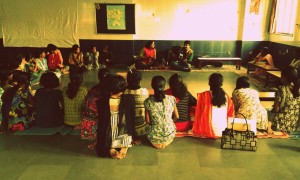30 years in G.B. Road, Delhi – Interview with Lalitha S.A.

In July 2019, a team from Prerana’s Anti-Trafficking Center visited Delhi to better understand the situation of sex trafficking in the capital. We had a chance to visit the red-light area located on and known by the name Garstin Bastion Road (G.B. Rd). We also had a chance to interact with Ms. Lalitha S.A, the founder of Mashal Shiksha Kendra (At present known as SMS Centre).
Lalitha grew up and studied in the Indian state of Karnataka. She holds a Masters in Political Science and has been working in the development sector for the past 30+ years. Lalitha began her work in the anti-trafficking sector back home in Karnataka when she was a part of a Civil Society Organization that worked with the Devadasi community. Devadasis are “servants of god”. It’s an age-old practice where young girls are “married” to an idol, deity, or temple. These girls are often from the lowest castes in India, their parents have given them to temples as human offerings in order to appease the gods. Lalitha’s focus area of work was on the children of the Devadasi women. This was her first exposure to the issue of sex trafficking and commercial sexual exploitation of women. The SMS center was founded in 1991 by Lalitha and provides 24-hour care for children of women victims of commercial sexual exploitation and trafficking who live in the brothels of G.B. Rd. In 2009, SMS partnered with Society for Participatory Integrated Development (SPID) and the center has since been referred to as the SPID-SMS center. Lalitha is also the Vice President of SPID.
Here is the interview conducted with Ms. Lalitha as we discussed her initial days working on G.B. Rd., the current situation of trafficking in Delhi and her views on the legalization of the trade, documented by Ms. Flarantxa Pereira.
> Why did you begin your work in G.B. Rd.?
Lalitha: Back in the mid-80s, I used to work for an NGO that worked with the urban poor. At that time, here in Delhi, I was also a part of a local activist group. These were people from different backgrounds who wanted to make a difference in society. We used to discuss a number of different issues. During one meeting, one of the other members from the group who had just completed his MBBS shared that he wanted to take a break and do some social service. He spoke about G.B. Rd. and shared his experience there. This piqued an interest in me because I had previously worked with the Devadasi community and G.B. Rd. was synonymous with the sex trade. It was 1988 when the doctor and I began visiting G.B. Rd. I still remember my first day in the area, we were walking up the steps of a brothel, I went up to a few of the women there and began talking, it was as if they connected with me. Maybe it was my skin color, maybe it was because I could converse with them in their local language or maybe it was because I was a woman myself. I haven’t looked back since.
> How did your interventions in G.B. Rd. begin?
Lalitha: I had been regularly visiting the G.B. Rd. red-light area since 1988. Our first two years were just about learning and building relationships. In 1989, All India Institute of Medical Sciences (AIIMS) and the Indian Council of Medical Research (ICMR) forcibly tested the women for HIV/AIDS. This was done without raising awareness on the issue, the women didn’t know why they were being tested. During my visits to G.B. Rd., the women would come up to me and ask me about HIV, they all wanted to know what it was. Around that time our activist group began talking about the HIV virus, the more information we gathered the more we took to the red-light area. One could say we first began working with the women on the issue of HIV/AIDS. There weren’t any NGOs or even people working in the area at the time, especially not on this issue. No one was talking about prevention, no one knew how to prevent it. So, we began outreach in the community and started suggesting the use of condoms as a form of prevention, and there we faced a challenge. The women and the Ministry of Health and Family Welfare were of the opinion that condoms were only used for ‘family planning’ something like HIV couldn’t be prevented using condoms, they also didn’t want to talk about HIV, as we know, there was and continues to be a stigma attached to it. If the women didn’t want to openly talk about HIV, we had to change the way we approached it, so we began talking about family planning and why it was important, emphasizing on the use of condoms. To an extent, this helped, but the information available to us was also minimum. Then in 1989, the first case of HIV to reach the Indian courts was reported. It was the case of Mr Dominic D’Souza, incarcerated in 1989 as he was diagnosed HIV+. Our activist group was in close contact with him and closely supported his cause. He visited Delhi and was a part of a local protest we had organized to raise awareness about HIV. This was where we got a number of women from the red-light area to attend. I think this was the first public protest program these women were ever a part of.
> What were your reasons to start the SMS center?
Lalitha: The women of G.B. Rd asked for it. They would come to me daily saying “Akka, (Sister) there is no one here to take care of our children, please do something for our children”. So, we did our best to make it happen. You see, before this center, there was nowhere for the children to go. Very few mothers would get their children educated. The children would live in the brothel with their mother. Each brothel would have 10 to 15 other women staying along with a brothel keeper and a manager. The mothers didn’t have their own space not even a bed for themselves. The children weren’t safe in the brothels if they were seen roaming around the brothel keeper would hit them. If not, the brothel keeper it would be the other women living there. It wasn’t just that, the chances of a child being inducted into the trade were extremely high, the brothel keeper had easy access to the child and so did the pimp. In a way, we started the center to ensure that second-generation trafficking doesn’t take place.
Aside from that, in 1989, I remember, the Government of Delhi announced a scheme to ‘adopt children of prostitutes’, they partnered with an NGO and came to G.B. Rd. Together they took a lot of pictures, ‘adopted’ many children and moved them to Village Cottage Homes in Delhi. The mothers didn’t have access to their children, they didn’t know where they were nor could they meet them. The mothers didn’t want to be separated from their children. The mothers would come to me and say, ‘Akka, why does the Government need to adopt our children, don’t they already have a mother?’
The mothers are earning members of society, much like the other mainstream mothers. These women also deserve the right to take care of their children and a facility that can assist them in doing that. Working individuals have a set number of hours, but these women have to ‘work’ whenever they are told. They don’t have specific hours; they don’t have a place of their own but they are still mothers and have a right to care for their children themselves. We had a child living with us, one day she came up to me and said ‘Akka, all these uncles come, pull my maa (Mother) and give her a kiss. I don’t like it.’. The children living in the brothels see inappropriate things, hear inappropriate things, they learn of things early on. Who is there to protect them? just their mothers, but their mothers need to be protected too. The children don’t have a safe space, nor do they deserve to be separated from their families because of where they live. If a ‘normal family’ is also not always safe for a child, how can a brothel be? In 1990, a consultation meeting organized by the Government of India, the theme was ‘Rehabilitation for Prostitutes and their Children’. Government officials from a number of States, Law Makers, Activist Groups and Civil Society Organizations participated in the discourse. They invited me too, I requested that they allow me to get a few women from G.B. Rd. along, after all, they were discussing the future of these women. Initially, there was resistance, but finally, they allowed me to get five women to attend the meeting. One of the main recommendations from the women was for a ‘better future for their children’. These reasons are what motivated us to open the center in 1991.
> What were the challenges faced when opening the Drop-in-Center?
Lalitha: When we opened the daycare center in 1991, which was later converted into 24×7 Drop-in-Center, we started with just one small room, that was all the authorities gave us. Later on, the Government wanted to convert this into a hospital. We faced so many problems. There was a time we didn’t have access to toilets in the center and had to take the children to the public toilet. This center you see now, it took us 20+ years to get this kind of space. We never faced a problem from the community; our problem was with the few of the authorities.
After the Juvenile Justice (Care and Protection of Children) Act, 2015, the Drop-In-Center was converted into Open Shelter, the authorities have since been more supportive and even helped us get more space for the center.
Another challenge we faced is that of mothers taking their children and leaving the area with no way of tracing them. You see, when the child is enrolled at the center, we do it because they need protection and a safe place to live. These enrollments are done by either the mother, the pimp or the brothel keeper. Our challenge is getting the right name of the child. The mother will give one name, the pimp will give another. I think identity in the red-light area is one of the biggest problems. Sometimes mothers will never use their actual name. Once they leave G.B. Rd they’re gone forever, unless they choose to return themselves.
> What are the trends in sex trafficking and prostitution that you have seen? How have they changed over the last 30 years?
Lalitha: When I began working in the area, a number of women had been trafficked from all parts of India and of course there were minors. But that was 20 years ago, today you would see a dearth of minors in the area. That is not to say that minors aren’t being trafficked, they are, just the location has changed. Now if a minor is trafficked, she is kept on the outskirts of the city. She is groomed there and once she turns 18, she is then brought to G.B. Rd. There is a sense of fear when it comes to bringing minors into the area, I think this is because of the increase in awareness and involvement of law enforcement.
Today, you wouldn’t see many women from the south of India but rather from the north of India, a number of young women are trafficked from many parts of India. The means used to lure them, continue to remain similar.
Raids are conducted very often, not so much by the Delhi Police but by the police from the other Indian states. This also contributes to the fear of the pimps with regard to keeping minors in the area. The number of pimps in the area has increased. Twenty years ago, the balconies didn’t have grills, but the number of ‘accidental’ deaths kept increasing and they had no other option but to put in the grills. I say ‘accidental’ because the chances of a woman are being pushed to death by a customer, ‘so-called husband’ and others are very high.
Everyone focuses on the red-light area; they focus on the brothels. The target is always the brothels. But the sex trade is bigger than that. The trade isn’t limited to G.B. Road or Kamathipura or Sonagachi anymore, it is everywhere. Every village, city or community has the sex trade, but it’s hidden. It happens in houses, bungalows, in the so-called ‘good’ communities, it is everywhere! All they have to say is that they are a family and they get away with it. The sex trade is everywhere, but it is hidden.
> How safe is it to work and run an NGO in G.B. Rd.?
Lalitha: For you, as a woman you are very safe, I will even say that you are safer here than you would be in most parts of Delhi. But I can’t say the same for men. Men in the area are the most unsafe, the pimps will pull them if they are walking by, they will jump into auto-rickshaws. And if they see a bag in the man’s hand, well they will do anything they can to get him to go with them. Here no one will touch a woman, they will pass lewd comments but they won’t touch you.
G.B. Rd. is a connector street, it in a way connects Old Delhi to New Delhi. The roads here are always bustling, this is one of the largest hardware markets in the city. Men wouldn’t look at you as much as they’d look upwards to the women behind the grills.
Though G.B. Rd. has always been and continues to be a hideout for criminals. You see, one never knows who goes into the brothel and who leaves. One thing to remember, G.B. Rd. is safe for you and me, but it isn’t for the women trafficked here.
> What are your thoughts on the legalization of the sex trade?
Lalitha: I have never fought for the legalization of the trade, I never will. These women first need to have access to basic human rights that they are entitled to. There is no need to legalize the trade, bodies aren’t and shouldn’t be for sale. This lobby first began its work on issues related to HIV/AIDS and then a few of them felt like they need to have a conversation around legalization. Some of them were under the western influence, but they didn’t and still don’t understand the issues a majority of Indian women will face if the trade is legalized. When this was first discussed we met with the women to understand what they thought of having the trade legalized, they said ‘Akka, tell me one way the license will help us? It will just prove who we are. People still won’t accept us. And who’s to say 10 girls won’t use one license?’.
When someone asks me why I am against legalization, I always ask one question – what is the situation of the girl child in our country today? Legalizing the trade would give the exploiter an easier and more legitimate way to exploit the vulnerable.
> Do you think there is a need for new laws to fight trafficking?
Lalitha: I think there is a need for the existing laws to first be implemented. How many more laws will you make before you actually start enforcing them. The more laws we make the more confusion it creates. It would be nice to have just one law for cases of trafficking, but we need to first understand how to use the laws we already have.
I’d like to end with this, the problem isn’t insurmountable, and the difficulties come from those who are meant to solve the problem.

Flarantxa Pereira
Flarantxa joined Prerana in January 2018 and works closely with documentation of many Prerana projects. She is also an integral part of Prerana’s Communications team. Apart from this, she also works closely on a field project with students in a low-income school in Mumbai. Flarantxa aspires to inspire change through thoughtful stories and impactful design.
Read more
The blog post was first published on Dr. Pravin Patkar's Blog 'Expressions'. The post sheds light on the impact and Read more
Trauma cannot be addressed as a standalone problem. It needs to be addressed holistically, keeping in mind various experiences and Read more



